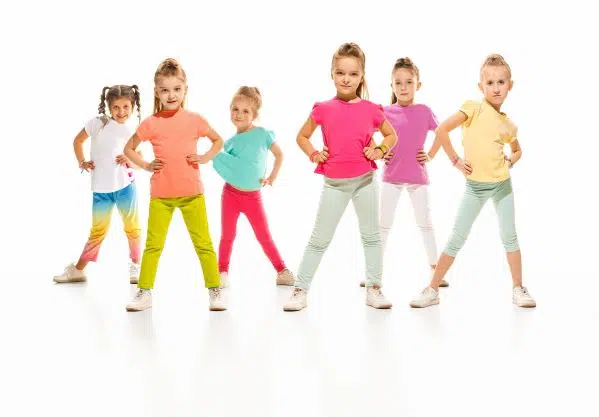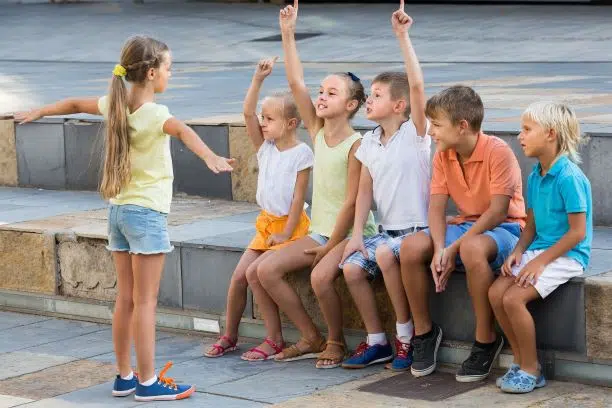Simon Says is a classic game that most children really love, and that is great for teaching the key skill of listening.
In ten years of teaching children between the ages of 3-5, I have also tried out a whole host of games that are either a direct variation of Simon Says, or that use the same kinds of elements in the game.
These have gone down really well also. They keep the Simon Says concept fresh, and they incorporate all sorts of new elements and fun skills as well.
The best 12 games like Simon Says that I’ll be looking at in this article are:
1.Simon Says Theme
2. Simon Says Blending
3. Simon Says Rhyme
4. Simon Says, Go On An Adventure
5. Simon Says, Roll The Ball
6. Do As Simon Says, Not As He Does
7. Copy Cats
8. Copy Cats Freeze
9. Do As I Say, Not As I Do
10. Copy Cats Pairs
11. Pied Piper Game
12. Follow The Leader
All of these are perfect for children between the ages of 3 to about 6. You can use them in school, preschool, outer school sports clubs, camps, and pretty much anywhere else if you are looking for fun warm-ups for young children.

1. Simon Says Theme
The idea of this one, as you can probably guess from the title of it, is to pick a theme.
It is good if you pick something that the children are interested in. Something like superheroes, or vehicles, or animals would all work really well.
Let’s imagine you pick animals as a theme.
The instructions in this Simon Says would all link to animals. So it might be things like:
‘Simon Says let’s see your monkey arms!’
‘Simon Says have one arm like a trunk, and the other an elephant ear!’
Same as with all these games, if you don’t say ‘Simon Says’ then the children don’t do it (you probably knew that!).
So, if you say, ‘Make your arms like chicken wings!’ then children don’t do it. That’s where the elements of fun and listening really come in.
2. Simon Says Blending
Simon Says can be used for quite a few different phonics and early literacy skills.
Here is one good example.
In this game, you break up one word of the instruction that you give into sound-talk.
For example, it might sound like this – ‘Simon Says, put your hands on your ch-i-n.’ (Ch-i-n) ‘Simon Says, put your hands on your f-ee-t.’ (Feet!)
Blending is possibly the most important skill of early reading, and often the area that most children get stuck on. Incorporating blending into fun and active listening games like this is a great way of practising the skill in a fun context.
3. Simon Says, Go On An Adventure
This is a great Simon Says game that gets the children moving about a space.
Have some kind of large space for this that the children can move about in safely.
Quite simply, the person giving the instructions this time will describe some kind of exploration or mini-adventure, and the children will act it out. It will be things like:
‘Simon Says sneak on your tiptoes through the spooky forest.’
‘Simon Says climb a tree.’
‘Simon Says swing through the vines.’
‘Simon Says get on the eagle’s back and fly through the trees.’
Children act all of these things out, always waiting for the instruction where there is no ‘Simon Says.’
4. Simon Says Rhyme
Rhyme is another key skill of early phonics.
It is not easy, though, and many children find learning to rhyme one of the hardest elements of early literacy.
However, fun games like Simon Says may help this process for some.
Basically, the person giving the instructions will say something that rhymes. Examples are:
‘Simon Says put your hands on something that rhymes with zelly.’ (Belly)
‘Simon Says put your hands on something that rhymes with zee-cap.’ (Knee-cap)
That’s all there is to it.
The longer the word, the easier it actually is for them to get. Words with two or three syllables are the way to go if you can think of them.
Words with just one syllable in are much harder for this game. For examples, instructions like:
‘Simon Says put your hands on something that rhymes with zed.’ (Head).
‘Simon Says put your hands on something that rhymes with zips.’ (Lips)
Much trickier! So, to summarize, start with words that are longer, and see how they get on. If they are doing well, you can transition over to shorter words.
Some good examples of longer body part words include:
- Fingers
- Rib-cage
- Forearm
- Big toe
- Pointy finger
There are obviously loads more examples than this as well.
Quick note – I always add a ‘z’ to the word (as you can see above). There is no real reason for this, other than it is something I have always done. You could definitely experiment with trying a different sound at the start of these words.
5. Simon Says, Roll The Ball
This is Simon Says adapted as a circle game.
Get the children to stand in a circle, and you need one large ball for this (something like a big sponge or rubber ball would be perfect).
One child starts with the ball. They say an instruction for the Simon Says game. Something like:
‘Simon Says stand on one leg.’
Then they pick another child in the circle, and say their name, e.g. ‘Billy’. They roll the ball to them.
Then it is the next child’s go to say an instruction which everyone does. Then they pick the next child, roll the ball to the them, and so on.
Older children could throw the ball to each other, but if they are not great at catching I would just go with a roll as being easier.
Once again, children can choose whether to try to trick the other children by not saying ‘Simon Says’ as part of their instruction.

6. Do As Simon Says, Not As He Does
This is a really fun game that the all enjoy.
The idea of this is that the person (either adult or child) giving the instructions is going to say one thing, but do something different themselves. The children need to do what Simon says, but not what he does.
So, as an example, you might say, ‘Simon Says put your hands on your knees.’ But then put your hands on your shoulders yourself.
The children are going to try to put their hands on their knees (not their shoulders).
This really gets them thinking! And they find it quite funny as well.
Keep going like this, trying to trick them.
7. Copy Cats
Now for a few games that are strongly linked to Simon Says, but are also a little bit different.
The first one is ‘Copy Cats’.
One person is the leader in this game, and the others are going to copy them. The person who is ‘on’ could be an adult or a child (it is up to you.)
That person is going to move about in a certain way. Once again, this one is quite nice if you pick a theme.
You could move like animals, or vehicles, or superheroes.
To take the example of vehicles, the person who is ‘on’ might move about the space like a plane, with arms outstretched.
Everyone will copy.
Then they might change to being a train, with chugging arms.
Everyone copies.
The idea is to keep your eye on the person who is ‘on’ and always copy what they are doing.
8. Copy Cats Freeze
This is an adaption of the simple Copy Cats game.
In this, play Copy Cats as described above. However, this time, at any moment when they feel like it, the person who is ‘on’ is going to shout ‘Freeze!’
That’s the moment where everyone freezes.
Anyone that is moving is ‘out’, and has to go to sit at the side.
If you do something like Copy Cats with an animals theme for this game, the children will be frozen in all sorts of funny positions – like monkeys, elephants, snakes etc.
They really enjoy this, as well as it being an excellent listening game.
9. Do As I Say, Not As I Do
This is a slightly harder version of Copy Cats.
The person who is ‘on’ this time is going to say one thing, but do another.
So they might say, ‘Run around like a monkey’, but they themselves will start slithering like a snake.
The children must run like monkeys (not slither like snakes).
10. Copy Cats Pairs
This is a version of the Copy Cats game for pairs of children.
Split the children up into pairs, and pick one person to be ‘on’ out of each pair.
That person is going to be the leader, and decide how the pair will move. The other person is going to copy them.
Have a go for a few minutes, and then swap who is the leader so they both get a fair go.
11. Pied Piper Game
This is a simple follow the leader game.
One person goes at the front. To start with it makes sense if this is the adult, but it could definitely be a child when the children have got to grips with how to play the game.
The children are going to stand in a line behind the person at the front.
The person at the front is the ‘Pied Piper.’ They are going to start moving about the space in whatever way they like. The children are going to follow them, moving in an identical way.
Some good ways to move include:
- Going on tiptoes
- Stamping like a giant
- Slithering like snakes
- Moving like different animals
- Moving really low, or really tall
- Going fast, slow
- Moving side to side
The children all follow!
12. Pied Piper Freeze!
This game starts off just like the Pied Piper game above.
The children move around the room, following in the footsteps of the leader who will be moving in all sorts of different ways.
At any given moment, the Pied Piper at the front will shout ‘Freeze!’
All the children will freeze in whatever funny poses they are currently in.
The Pied Piper will go down the line, checking to see if anyone is moving. If so, they will let them know! You could potentially do the version where if you move you are out!
